+ Open data
Open data
- Basic information
Basic information
| Entry | Database: PDB / ID: 5brz | ||||||
|---|---|---|---|---|---|---|---|
| Title | MAGE-A3 reactive TCR in complex with MAGE-A3 in HLA-A1 | ||||||
 Components Components |
| ||||||
 Keywords Keywords | IMMUNE SYSTEM / Immuno pMHC TCR MAGE | ||||||
| Function / homology |  Function and homology information Function and homology informationcaspase binding / alpha-beta T cell receptor complex / negative regulation of protein processing / positive regulation of memory T cell activation / T cell mediated cytotoxicity directed against tumor cell target / TAP complex binding / Golgi medial cisterna / positive regulation of CD8-positive, alpha-beta T cell activation / CD8-positive, alpha-beta T cell activation / positive regulation of CD8-positive, alpha-beta T cell proliferation ...caspase binding / alpha-beta T cell receptor complex / negative regulation of protein processing / positive regulation of memory T cell activation / T cell mediated cytotoxicity directed against tumor cell target / TAP complex binding / Golgi medial cisterna / positive regulation of CD8-positive, alpha-beta T cell activation / CD8-positive, alpha-beta T cell activation / positive regulation of CD8-positive, alpha-beta T cell proliferation / T cell receptor complex / CD8 receptor binding / Translocation of ZAP-70 to Immunological synapse / antigen processing and presentation of exogenous peptide antigen via MHC class I / Phosphorylation of CD3 and TCR zeta chains / beta-2-microglobulin binding / endoplasmic reticulum exit site / TAP binding / antigen processing and presentation of endogenous peptide antigen via MHC class I via ER pathway, TAP-dependent / protection from natural killer cell mediated cytotoxicity / alpha-beta T cell activation / Generation of second messenger molecules / Co-inhibition by PD-1 / antigen processing and presentation of endogenous peptide antigen via MHC class Ib / antigen processing and presentation of endogenous peptide antigen via MHC class I via ER pathway, TAP-independent / immune system process / detection of bacterium / negative regulation of endoplasmic reticulum stress-induced intrinsic apoptotic signaling pathway / T cell receptor binding / negative regulation of autophagy / negative regulation of receptor binding / early endosome lumen / Nef mediated downregulation of MHC class I complex cell surface expression / DAP12 interactions / transferrin transport / cellular response to iron ion / Endosomal/Vacuolar pathway / Antigen Presentation: Folding, assembly and peptide loading of class I MHC / response to bacterium / peptide antigen assembly with MHC class II protein complex / lumenal side of endoplasmic reticulum membrane / cellular response to iron(III) ion / MHC class II protein complex / negative regulation of forebrain neuron differentiation / antigen processing and presentation of exogenous protein antigen via MHC class Ib, TAP-dependent / ER to Golgi transport vesicle membrane / peptide antigen assembly with MHC class I protein complex / regulation of iron ion transport / regulation of erythrocyte differentiation / HFE-transferrin receptor complex / response to molecule of bacterial origin / MHC class I peptide loading complex / T cell mediated cytotoxicity / positive regulation of T cell cytokine production / antigen processing and presentation of endogenous peptide antigen via MHC class I / antigen processing and presentation of exogenous peptide antigen via MHC class II / positive regulation of immune response / MHC class I protein complex / positive regulation of T cell activation / peptide antigen binding / positive regulation of receptor-mediated endocytosis / negative regulation of neurogenesis / cellular response to nicotine / positive regulation of T cell mediated cytotoxicity / multicellular organismal-level iron ion homeostasis / histone deacetylase binding / specific granule lumen / positive regulation of type II interferon production / phagocytic vesicle membrane / recycling endosome membrane / Interferon gamma signaling / Immunoregulatory interactions between a Lymphoid and a non-Lymphoid cell / negative regulation of epithelial cell proliferation / MHC class II protein complex binding / Interferon alpha/beta signaling / Modulation by Mtb of host immune system / late endosome membrane / sensory perception of smell / positive regulation of cellular senescence / antibacterial humoral response / tertiary granule lumen / DAP12 signaling / Downstream TCR signaling / T cell differentiation in thymus / T cell receptor signaling pathway / E3 ubiquitin ligases ubiquitinate target proteins / negative regulation of neuron projection development / ER-Phagosome pathway / protein refolding / early endosome membrane / protein homotetramerization / amyloid fibril formation / adaptive immune response / intracellular iron ion homeostasis / learning or memory / cell surface receptor signaling pathway / defense response to Gram-positive bacterium / immune response / endoplasmic reticulum lumen / Amyloid fiber formation Similarity search - Function | ||||||
| Biological species |  Homo sapiens (human) Homo sapiens (human) | ||||||
| Method |  X-RAY DIFFRACTION / X-RAY DIFFRACTION /  SYNCHROTRON / SYNCHROTRON /  MOLECULAR REPLACEMENT / MOLECULAR REPLACEMENT /  molecular replacement / Resolution: 2.62 Å molecular replacement / Resolution: 2.62 Å | ||||||
 Authors Authors | Raman, M.C.C. / Rizkallah, P.J. / Simmons, R. / Donnellan, Z. / Dukes, J. / Bossi, G. / LeProvost, G. / Mahon, T. / Hickman, E. / LomaX, M. ...Raman, M.C.C. / Rizkallah, P.J. / Simmons, R. / Donnellan, Z. / Dukes, J. / Bossi, G. / LeProvost, G. / Mahon, T. / Hickman, E. / LomaX, M. / Oates, J. / Hassan, N. / Vuidepot, A. / Sami, M. / Cole, D.K. / Jakobsen, B.K. | ||||||
 Citation Citation |  Journal: Sci Rep / Year: 2016 Journal: Sci Rep / Year: 2016Title: Direct molecular mimicry enables off-target cardiovascular toxicity by an enhanced affinity TCR designed for cancer immunotherapy. Authors: Raman, M.C. / Rizkallah, P.J. / Simmons, R. / Donnellan, Z. / Dukes, J. / Bossi, G. / Le Provost, G.S. / Todorov, P. / Baston, E. / Hickman, E. / Mahon, T. / Hassan, N. / Vuidepot, A. / ...Authors: Raman, M.C. / Rizkallah, P.J. / Simmons, R. / Donnellan, Z. / Dukes, J. / Bossi, G. / Le Provost, G.S. / Todorov, P. / Baston, E. / Hickman, E. / Mahon, T. / Hassan, N. / Vuidepot, A. / Sami, M. / Cole, D.K. / Jakobsen, B.K. | ||||||
| History |
|
- Structure visualization
Structure visualization
| Structure viewer | Molecule:  Molmil Molmil Jmol/JSmol Jmol/JSmol |
|---|
- Downloads & links
Downloads & links
- Download
Download
| PDBx/mmCIF format |  5brz.cif.gz 5brz.cif.gz | 347.7 KB | Display |  PDBx/mmCIF format PDBx/mmCIF format |
|---|---|---|---|---|
| PDB format |  pdb5brz.ent.gz pdb5brz.ent.gz | 283.7 KB | Display |  PDB format PDB format |
| PDBx/mmJSON format |  5brz.json.gz 5brz.json.gz | Tree view |  PDBx/mmJSON format PDBx/mmJSON format | |
| Others |  Other downloads Other downloads |
-Validation report
| Summary document |  5brz_validation.pdf.gz 5brz_validation.pdf.gz | 473.4 KB | Display |  wwPDB validaton report wwPDB validaton report |
|---|---|---|---|---|
| Full document |  5brz_full_validation.pdf.gz 5brz_full_validation.pdf.gz | 490.3 KB | Display | |
| Data in XML |  5brz_validation.xml.gz 5brz_validation.xml.gz | 30.3 KB | Display | |
| Data in CIF |  5brz_validation.cif.gz 5brz_validation.cif.gz | 41.6 KB | Display | |
| Arichive directory |  https://data.pdbj.org/pub/pdb/validation_reports/br/5brz https://data.pdbj.org/pub/pdb/validation_reports/br/5brz ftp://data.pdbj.org/pub/pdb/validation_reports/br/5brz ftp://data.pdbj.org/pub/pdb/validation_reports/br/5brz | HTTPS FTP |
-Related structure data
| Related structure data |  5bs0C 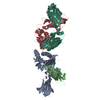 1w72S 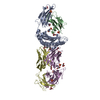 3o4lS C: citing same article ( S: Starting model for refinement |
|---|---|
| Similar structure data |
- Links
Links
- Assembly
Assembly
| Deposited unit | 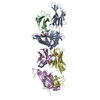
| ||||||||
|---|---|---|---|---|---|---|---|---|---|
| 1 |
| ||||||||
| Unit cell |
|
- Components
Components
-Protein , 4 types, 4 molecules ABDE
| #1: Protein | Mass: 31734.070 Da / Num. of mol.: 1 Source method: isolated from a genetically manipulated source Source: (gene. exp.)  Homo sapiens (human) / Gene: HLA-A, HLAA / Production host: Homo sapiens (human) / Gene: HLA-A, HLAA / Production host:  |
|---|---|
| #2: Protein | Mass: 11879.356 Da / Num. of mol.: 1 Source method: isolated from a genetically manipulated source Source: (gene. exp.)  Homo sapiens (human) / Gene: B2M, CDABP0092, HDCMA22P / Production host: Homo sapiens (human) / Gene: B2M, CDABP0092, HDCMA22P / Production host:  |
| #4: Protein | Mass: 21451.891 Da / Num. of mol.: 1 Source method: isolated from a genetically manipulated source Source: (gene. exp.)  Homo sapiens (human) / Gene: TRAV21, TRAC, TCRA / Production host: Homo sapiens (human) / Gene: TRAV21, TRAC, TCRA / Production host:  |
| #5: Protein | Mass: 27132.072 Da / Num. of mol.: 1 Source method: isolated from a genetically manipulated source Source: (gene. exp.)  Homo sapiens (human) / Gene: TCRBV5S1A1T, TRBV5-1, B2M, HDCMA22P / Production host: Homo sapiens (human) / Gene: TCRBV5S1A1T, TRBV5-1, B2M, HDCMA22P / Production host:  |
-Protein/peptide , 1 types, 1 molecules C
| #3: Protein/peptide | Mass: 1043.150 Da / Num. of mol.: 1 / Source method: obtained synthetically / Source: (synth.)  Homo sapiens (human) / References: UniProt: P43357*PLUS Homo sapiens (human) / References: UniProt: P43357*PLUS |
|---|
-Non-polymers , 2 types, 24 molecules 


| #6: Chemical | ChemComp-SO4 / #7: Water | ChemComp-HOH / | |
|---|
-Details
| Has protein modification | Y |
|---|
-Experimental details
-Experiment
| Experiment | Method:  X-RAY DIFFRACTION / Number of used crystals: 1 X-RAY DIFFRACTION / Number of used crystals: 1 |
|---|
- Sample preparation
Sample preparation
| Crystal | Density Matthews: 2.49 Å3/Da / Density % sol: 50.62 % |
|---|---|
| Crystal grow | Temperature: 291 K / Method: vapor diffusion, sitting drop Details: 0.2M ammonium chloride, 0.1M HEPES pH7, 15% PEG 8000 |
-Data collection
| Diffraction | Mean temperature: 100 K | |||||||||||||||||||||||||||
|---|---|---|---|---|---|---|---|---|---|---|---|---|---|---|---|---|---|---|---|---|---|---|---|---|---|---|---|---|
| Diffraction source | Source:  SYNCHROTRON / Site: SYNCHROTRON / Site:  Diamond Diamond  / Beamline: I02 / Wavelength: 0.9795 Å / Beamline: I02 / Wavelength: 0.9795 Å | |||||||||||||||||||||||||||
| Detector | Type: DECTRIS PILATUS 6M / Detector: PIXEL / Date: Jan 30, 2013 | |||||||||||||||||||||||||||
| Radiation | Protocol: SINGLE WAVELENGTH / Monochromatic (M) / Laue (L): M / Scattering type: x-ray | |||||||||||||||||||||||||||
| Radiation wavelength | Wavelength: 0.9795 Å / Relative weight: 1 | |||||||||||||||||||||||||||
| Reflection | Resolution: 2.62→82.01 Å / Num. obs: 27833 / % possible obs: 98.9 % / Redundancy: 3.6 % / CC1/2: 0.995 / Rmerge(I) obs: 0.107 / Rpim(I) all: 0.064 / Net I/σ(I): 12.4 / Num. measured all: 99682 | |||||||||||||||||||||||||||
| Reflection shell | Diffraction-ID: 1 / Rejects: _
|
-Phasing
| Phasing | Method:  molecular replacement molecular replacement | |||||||||
|---|---|---|---|---|---|---|---|---|---|---|
| Phasing MR | Model details: Phaser MODE: MR_AUTO
|
- Processing
Processing
| Software |
| ||||||||||||||||||||||||||||||||||||||||||||||||||||||||||||||||||||||||||||||||||||||||||||||||||||||||||||||||||||||||||||||||||||||||||||||||||||||||||||||||||||||||||||||||||||||||||||||||||||||||
|---|---|---|---|---|---|---|---|---|---|---|---|---|---|---|---|---|---|---|---|---|---|---|---|---|---|---|---|---|---|---|---|---|---|---|---|---|---|---|---|---|---|---|---|---|---|---|---|---|---|---|---|---|---|---|---|---|---|---|---|---|---|---|---|---|---|---|---|---|---|---|---|---|---|---|---|---|---|---|---|---|---|---|---|---|---|---|---|---|---|---|---|---|---|---|---|---|---|---|---|---|---|---|---|---|---|---|---|---|---|---|---|---|---|---|---|---|---|---|---|---|---|---|---|---|---|---|---|---|---|---|---|---|---|---|---|---|---|---|---|---|---|---|---|---|---|---|---|---|---|---|---|---|---|---|---|---|---|---|---|---|---|---|---|---|---|---|---|---|---|---|---|---|---|---|---|---|---|---|---|---|---|---|---|---|---|---|---|---|---|---|---|---|---|---|---|---|---|---|---|---|---|
| Refinement | Method to determine structure:  MOLECULAR REPLACEMENT MOLECULAR REPLACEMENTStarting model: 1W72 and 3O4L Resolution: 2.62→82.01 Å / Cor.coef. Fo:Fc: 0.952 / Cor.coef. Fo:Fc free: 0.905 / WRfactor Rfree: 0.2497 / WRfactor Rwork: 0.1761 / FOM work R set: 0.7991 / SU B: 30.693 / SU ML: 0.29 / SU R Cruickshank DPI: 0.3013 / SU Rfree: 0.3592 / Cross valid method: THROUGHOUT / σ(F): 0 / ESU R Free: 0.359 / Stereochemistry target values: MAXIMUM LIKELIHOOD Details: HYDROGENS HAVE BEEN ADDED IN THE RIDING POSITIONS U VALUES : WITH TLS ADDED
| ||||||||||||||||||||||||||||||||||||||||||||||||||||||||||||||||||||||||||||||||||||||||||||||||||||||||||||||||||||||||||||||||||||||||||||||||||||||||||||||||||||||||||||||||||||||||||||||||||||||||
| Solvent computation | Ion probe radii: 0.8 Å / Shrinkage radii: 0.8 Å / VDW probe radii: 1.2 Å / Solvent model: MASK | ||||||||||||||||||||||||||||||||||||||||||||||||||||||||||||||||||||||||||||||||||||||||||||||||||||||||||||||||||||||||||||||||||||||||||||||||||||||||||||||||||||||||||||||||||||||||||||||||||||||||
| Displacement parameters | Biso max: 166.93 Å2 / Biso mean: 62.589 Å2 / Biso min: 20.29 Å2
| ||||||||||||||||||||||||||||||||||||||||||||||||||||||||||||||||||||||||||||||||||||||||||||||||||||||||||||||||||||||||||||||||||||||||||||||||||||||||||||||||||||||||||||||||||||||||||||||||||||||||
| Refinement step | Cycle: final / Resolution: 2.62→82.01 Å
| ||||||||||||||||||||||||||||||||||||||||||||||||||||||||||||||||||||||||||||||||||||||||||||||||||||||||||||||||||||||||||||||||||||||||||||||||||||||||||||||||||||||||||||||||||||||||||||||||||||||||
| Refine LS restraints |
| ||||||||||||||||||||||||||||||||||||||||||||||||||||||||||||||||||||||||||||||||||||||||||||||||||||||||||||||||||||||||||||||||||||||||||||||||||||||||||||||||||||||||||||||||||||||||||||||||||||||||
| LS refinement shell | Resolution: 2.62→2.688 Å / Total num. of bins used: 20
| ||||||||||||||||||||||||||||||||||||||||||||||||||||||||||||||||||||||||||||||||||||||||||||||||||||||||||||||||||||||||||||||||||||||||||||||||||||||||||||||||||||||||||||||||||||||||||||||||||||||||
| Refinement TLS params. | Method: refined / Refine-ID: X-RAY DIFFRACTION
| ||||||||||||||||||||||||||||||||||||||||||||||||||||||||||||||||||||||||||||||||||||||||||||||||||||||||||||||||||||||||||||||||||||||||||||||||||||||||||||||||||||||||||||||||||||||||||||||||||||||||
| Refinement TLS group |
|
 Movie
Movie Controller
Controller



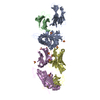
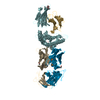
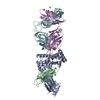
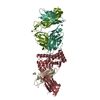
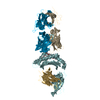
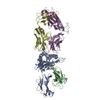
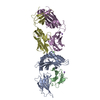
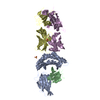
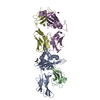
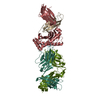

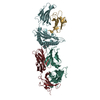
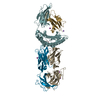
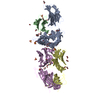
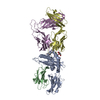
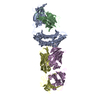
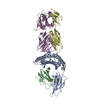
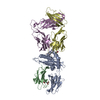
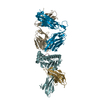
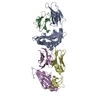
 PDBj
PDBj







